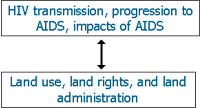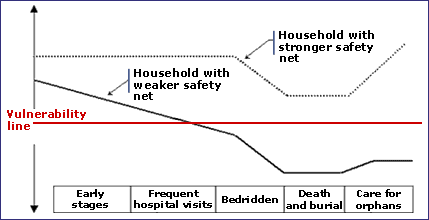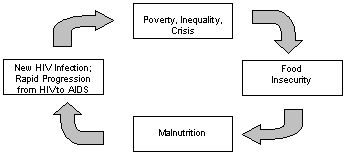
|
| Regional poverty themes |
|
HIV/AIDS and Land: Kenya, Lesotho, Malawi & South Africa
Social Aspects of HIV/AIDS Research Alliance Conference
1 – 4 September 2002 , Pretoria, South Africa
Dan Mullins - Oxfam GB Regional Management Centre, Pretoria
Scott Drimie - Human Sciences Research Council, Pretoria
E-mail: sedrimie@hsrc.ac.za
|
|
|
|
[ Share with a friend  ]
]
|
Background to the Study
Empirical data on links between land and AIDS
- FAO: Kenya, Lesotho, South Africa
- HSRC: coordination; South Africa
- Oxfam GB: Malawi
“If we do not explicitly factor in the impacts and trends of HIV/AIDS as a central feature of how to do land reform . . . We are being professionally negligent, misusing resources for poverty reduction, and are unlikely to achieved our objectives.”
Land policy encompasses .three main dimensions
- Land use
- Land rights
- Land administration
Two-Way Influence: HIV/AIDS and Land
|

|
HIV/AIDS and Land: Profound Challenge
Management challenge for those involved in land reform and rural development
Challenge to all aspects of land policy as it affects both:
-
people whom land policy is intended to benefit
-
people staffing the institutions that support the policy implementation
The effect of HIV/AIDS on households/livelihood strategies
|

|
Findings from the Studies
Impacts on Land Use
Change land use
- Lower productivity
- Less labour intensive uses
- Leave land fallow
Different users
- Rent or lease out land
- Enter into sharecropping or other contractual arrangements
- Lend land to others
Lose land
- Sell land formally or informally
- Abandon land
- Others forcibly take land way
Impacts on Land Use: Examples
- Gender and age: key influences everywhere
- Most sites: reduced agricultural yields
- Reduced labour due to illness, shift to increased caring demands
- Sale of productive assets: seeds, cattle
- Responsibility shifts to young and old
- Less experience and skills
 multi-generational impacts multi-generational impacts
- Changing amounts of land under use ?
- Kenya: significant reduction in cultivated land but
- Southern Malawi: high density, so land taken by new users
Land Use affects HIV/AIDS
Weakened livelihoods increase risks of HIV/AIDS
- new HIV transmission: women and girls engaging in sex work
- poverty and poor nutrition speed progress from HIV to AIDS
|

|
Impacts on Land Rights
Vulnerable people under increased pressure
- Gender and age: both affect ability to enjoy rights
Affects ability of widows, orphans, youth & children to:
- Access: participation in land reform / resettlement
- Use: for homestead, burial grounds, livelihoods activities
- Transact: inheritance by children, renting out by widows etc
- Exclude others: land grabbing and inheritance, control over decision-making (power taken by older people, especially men)
- Enforcement: legal and administrative system may not protect
Impacts on Land Rights: Examples
- Land-grabbing from widows in general: common but usually illegal
- Widows in KwaZulu Natal: increasingly resisted pressure to either relinquish their land or marry back into the husband's family
- Affected HHs in Lesotho: customary & formal law differ on fallow land
- Some chiefs allow affected households to retain fallow land for future
- Formal law seeks to keep land productive
- Children in Kenya: most affected through dispossession by ‘guardians’
- Youth-headed HHs in South Africa: vulnerable, not qualified to hold communal land
Impacts on Land Administration
Increasing illness & death of extension and land officials
- Productivity declines:
- staff absenteeism, illness, low morale,
- growing inefficiency
- Human resources affected:
- staff turnover, increasing competition for new staff, multiple recruitments
- declining levels of experience and quality
- Financial costs increase:
- medical care, funerals, induction and training
- actual survival of some organisations in question
Impacts on Land Administration: Examples
- Malawi: deaths of key personnel, recurrent illnesses of others have increased absenteeism, decreased performance
- Kenya: illness and death of land officials and chiefs stalled adjudication processes, and resulted in loss of institutional memory
Current Land Policy Framework
All 4 countries are reviewing land policy
None are actively considering current and future impacts of AIDS, on either:
- potential users
- implementing agencies
Recommendations
Put two-way links at centre of land policy and programmes:
HIV/AIDS <--> land use, land rights, and land administration
Collaboration between land and HIV/AIDS specialists: build on complementary skills to minimise HIV transmission and impacts
Understand heterogeneity: Seek to support diverse household types that result from HIV/AIDS impacts – influences of gender and age
Galvanise research, policy and implementation: to understand links between land and AIDS in a co-ordinated manner
Facilitate wider land use options: for both agricultural and non-farm activities, to be relevant to particularly vulnerable people (widows, orphans, youth and children, elderly); eg:
- develop land rental markets
- increase access to water for gardening purposes
Support rights of vulnerable people: Ensure needs of weaker individuals and households (gender, age, social situation) are addressed in land administration; eg land registration systems
Protect institutional capacity: Evaluate long-term capacity of land administration systems in light of HIV/AIDS among staff
|
|






